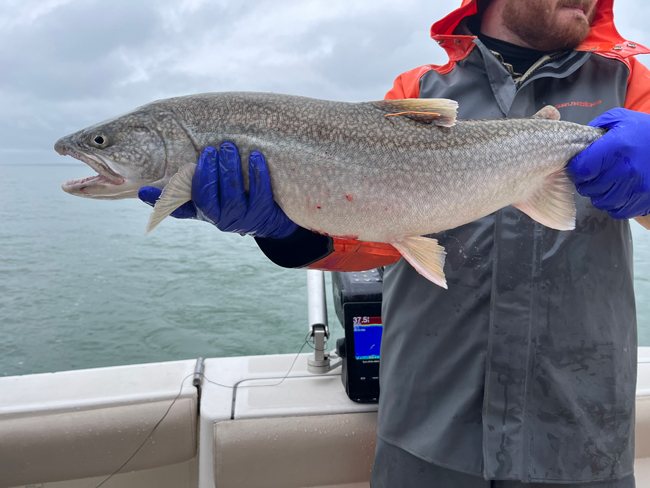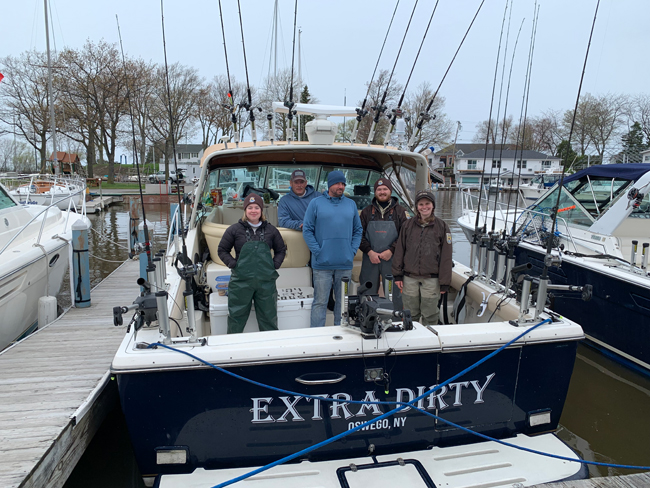
The orange-colored external acoustic tag, below the dorsal fin, identifies this fish as tagged in 2023. It is one of the first wild lake trout to be tagged in Lake Ontario. Credit: Jo Johnson/USFWS
Bi-National Effort Aimed at Survivability of Popular Sport Fishing Species
Contacts:
Stacy Furgal, New York Sea Grant Great Lakes Fisheries Specialist, E: slf85@cornell.edu, P: 315-312-3042
Kara Lynn Dunn, NYSG's Freelance Great Lakes Publicist, E: karalynn@gisco.net, P: 315-465-7578
Oswego, NY, June 7, 2023 - Lake trout research underway on Lake Ontario is part of the U.S.-Canada Cooperative Science and Monitoring Initiative (CSMI) field year on the lake. Research collecting data on lake trout movement using acoustic telemetry tags is being led by the U.S. Fish & Wildlife Service (USFWS) in collaboration with the U.S. Geological Survey (USGS), New York State Department of Environmental Conservation (DEC), Fisheries and Oceans Canada, Ontario Ministry of Natural Resources and Fisheries, with outreach assistance from New York Sea Grant (NYSG).
The research team is using specialized tags that communicate with acoustic receivers stationed on the lake bottom. The tags will provide information about the migration patterns and habitats used by adult lake trout. This innovative technology is particularly useful for locating spawning habitats and will help to inform future restoration efforts for potentially degraded spawning sites.
More than 350 lake trout will be tagged in 2023. The tags’ battery life allows for the fish to be tracked over the next 10 years.
This research has already produced a “first.”
“This work in 2023 represents the first time a wild-produced lake trout has ever been tagged in Lake Ontario”, said USFWS Fish Biologist Dimitry Gorsky, Ph.D. “Lake trout are a native species that is important to the ecosystem and to the world-class sport fishery on Lake Ontario.”
Gorsky is based at the USFWS Lower Great Lakes Fish and Wildlife Conservation Office, Basom, New York.
This research is funded in part through the U.S. Environmental Protection Agency Great Lakes Restoration Initiative.
Lake Ontario Charter Industry Assisting Research
The local charter fishing industry is assisting the research from ports at Mexico Bay, in eastern Lake Ontario, and Wilson, along the western end of the lake. Captain Casey Prisco and First Mates/Captains Roy Letcher and A.J. Berry of Dirty Goose Sport Fishing Charters, based in Pulaski, New York, were contracted to help the research team catch lake trout for the tagging study.
“In late April and early May, lake trout in the eastern end of Lake Ontario were found in deeper water, making them hard to collect with standard fisheries gear. Charter captains have a wealth of knowledge about the resource and are an efficient way for us to locate and collect the number of lake trout we need to tag,” said USGS Fish Research Biologist Alex Gatch of the USGS Tunison Lake Ontario Biological Station, Cortland, New York.
The tagged fish are returned to the water to resume normal behavior to assure quality data.
New York Sea Grant is providing public outreach support to inform angling, fisheries, and general public audiences about the value of this research.
NYSG Great Lakes Fisheries Specialist Stacy Furgal notes, “Tagged fish that are a part of this study are marked with an external orange-colored tag. If anglers catch a tagged lake trout they can choose to return it to the water, or if the fish is harvested, please contact Alex Gatch, agatch@usgs.gov, 607-753-9391 Ext 7540, to return the internal tracking tag.”

Lake trout researchers aboard Dirty Goose Sport Fishing Charters vessel at Wilson, New York, May 2023 (from left): USFWS Technician Alexa Davis, Dirty Goose First Mate/Captain Roy Letcher and Captain Casey Prisco, and USFWS Fish Biologists Kyle Morton and Jo Johnson. Credit: Stacy Furgal/New York Sea Grant
More Info: Project Partnerships
The U.S. Fish and Wildlife Service is the only federal agency with the primary responsibility for the conservation and management of fish, wildlife, plants, and their habitats for the American people.
The U.S. Geological Survey is the science arm of the U.S. Department of the Interior and provides an array of earth, water, biological, and mapping data and expertise in support of decision-making on environmental, resource, and public safety issues.
The Cooperative Science and Monitoring Initiative is a binational effort instituted under the Science Annex of the 2012 Great Lakes Water Quality Agreement to coordinate science and monitoring activities in one of the five Great Lakes each year to generate data and information for environmental management agencies.
More Info: New York Sea Grant
New York Sea Grant (NYSG), a cooperative program of Cornell University
and the State University of New York (SUNY), is one of 34 university-based
programs under the National Oceanic and Atmospheric Administration’s
National Sea Grant College Program.
Since 1971, NYSG has represented a statewide network of integrated
research, education and extension services promoting coastal community
economic vitality, environmental sustainability and citizen awareness
and understanding about the State’s marine and Great Lakes resources.
Through NYSG’s efforts, the combined talents of university scientists
and extension specialists help develop and transfer science-based
information to many coastal user groups—businesses and industries,
federal, state and local government decision-makers and agency managers,
educators, the media and the interested public.
The program maintains Great Lakes offices at Cornell University, SUNY
Buffalo, SUNY Oswego and the Wayne County Cooperative Extension office
in Newark. In the State's marine waters, NYSG has offices at Stony Brook
University and with Cornell Cooperative Extension of Nassau County on Long Island, Brooklyn College and Cornell Cooperative
Extension in NYC and Kingston in the Hudson Valley.
For updates on Sea Grant activities: www.nyseagrant.org has RSS, Facebook, Twitter, Instagram, and YouTube links. NYSG offers a free e-list sign up via www.nyseagrant.org/nycoastlines for its flagship publication, NY Coastlines/Currents, which is published quarterly.